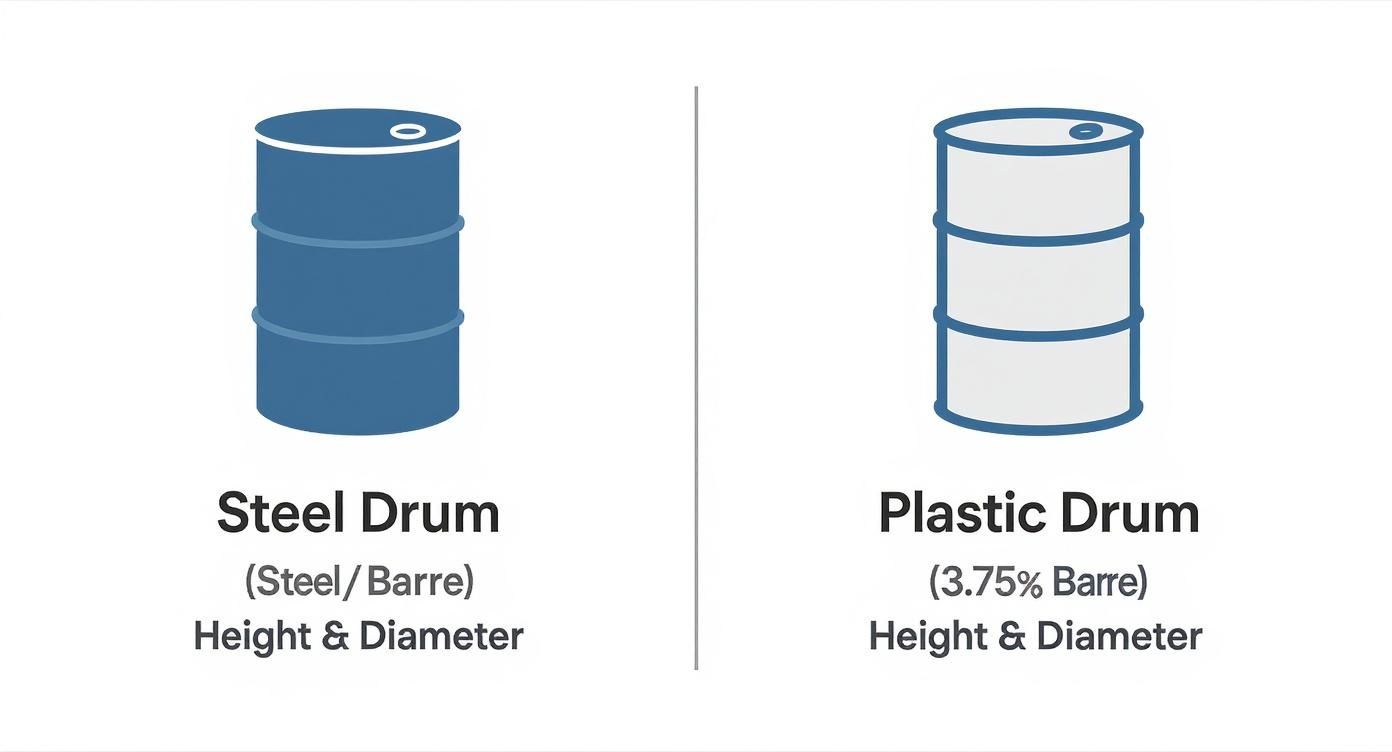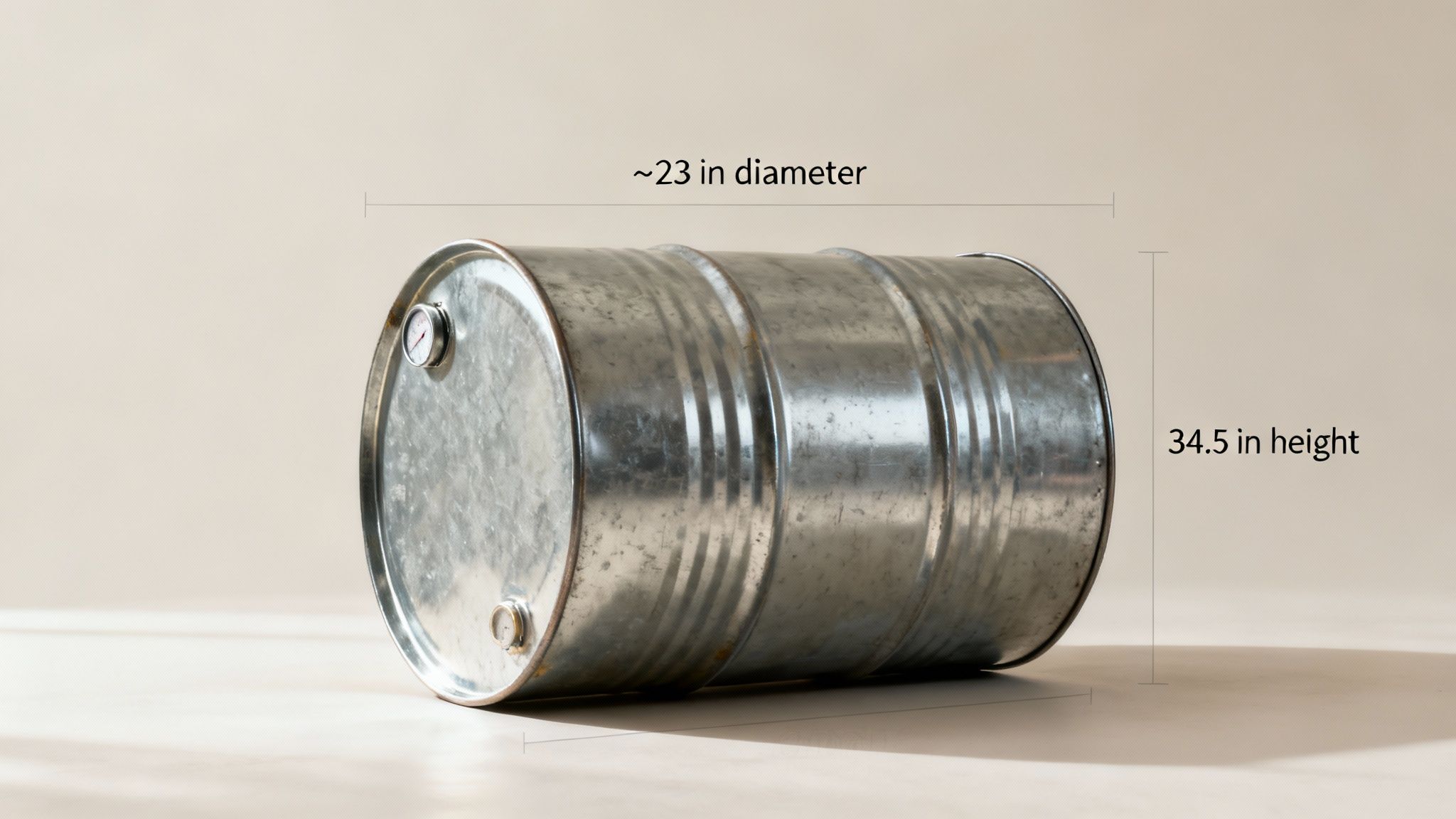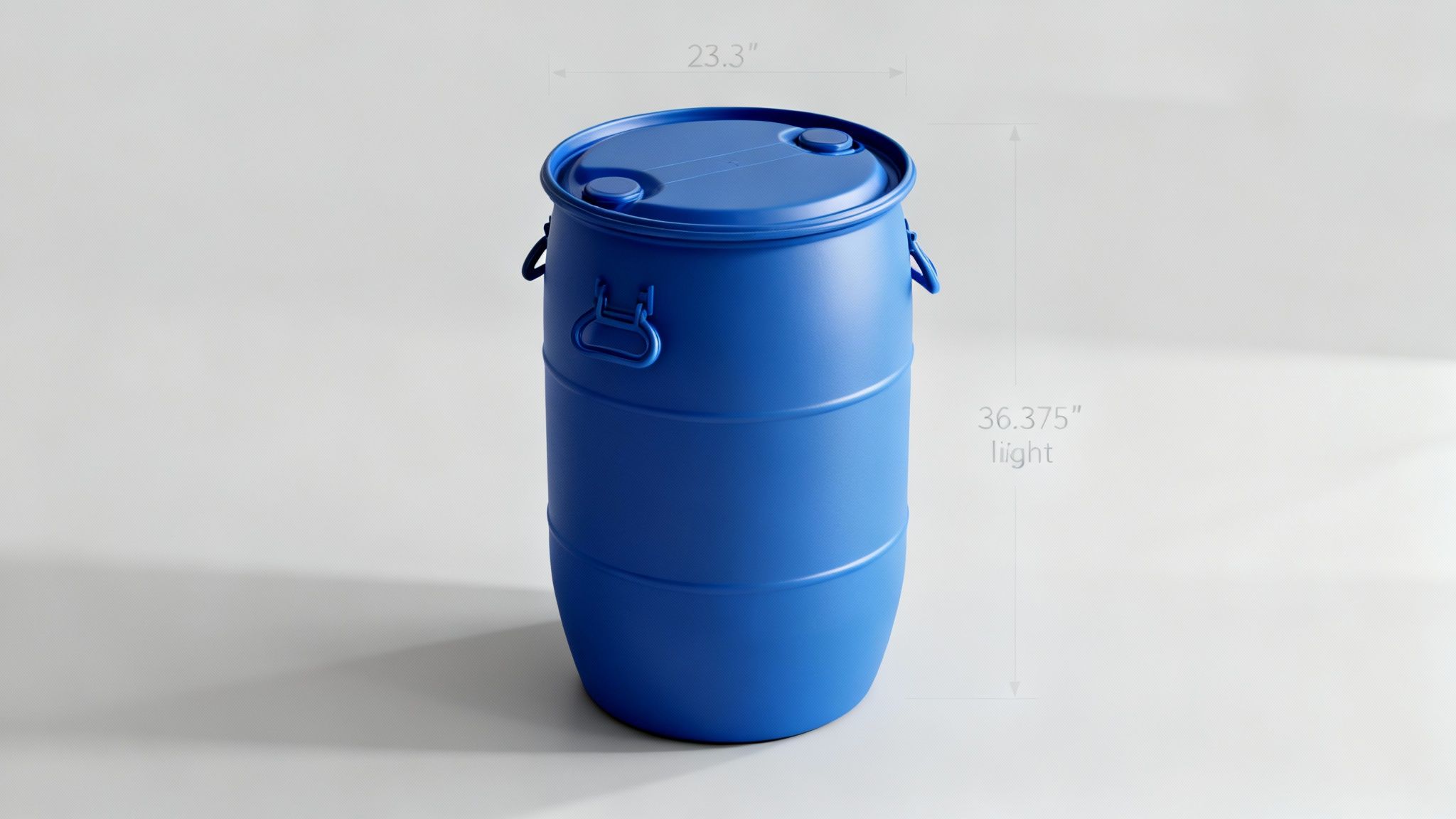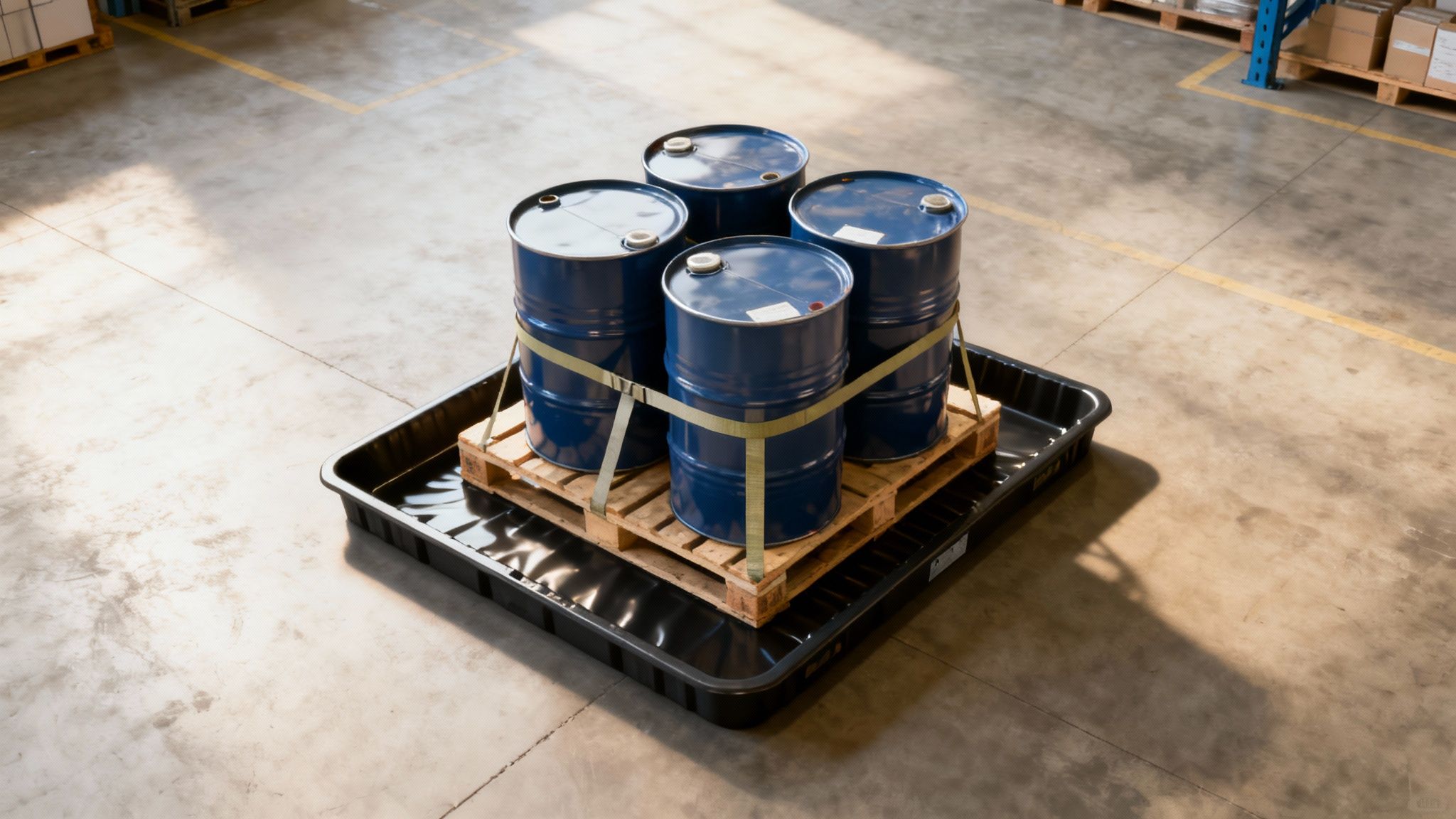Your cart is currently empty!
Tag: Plastic Barrel Specs
-
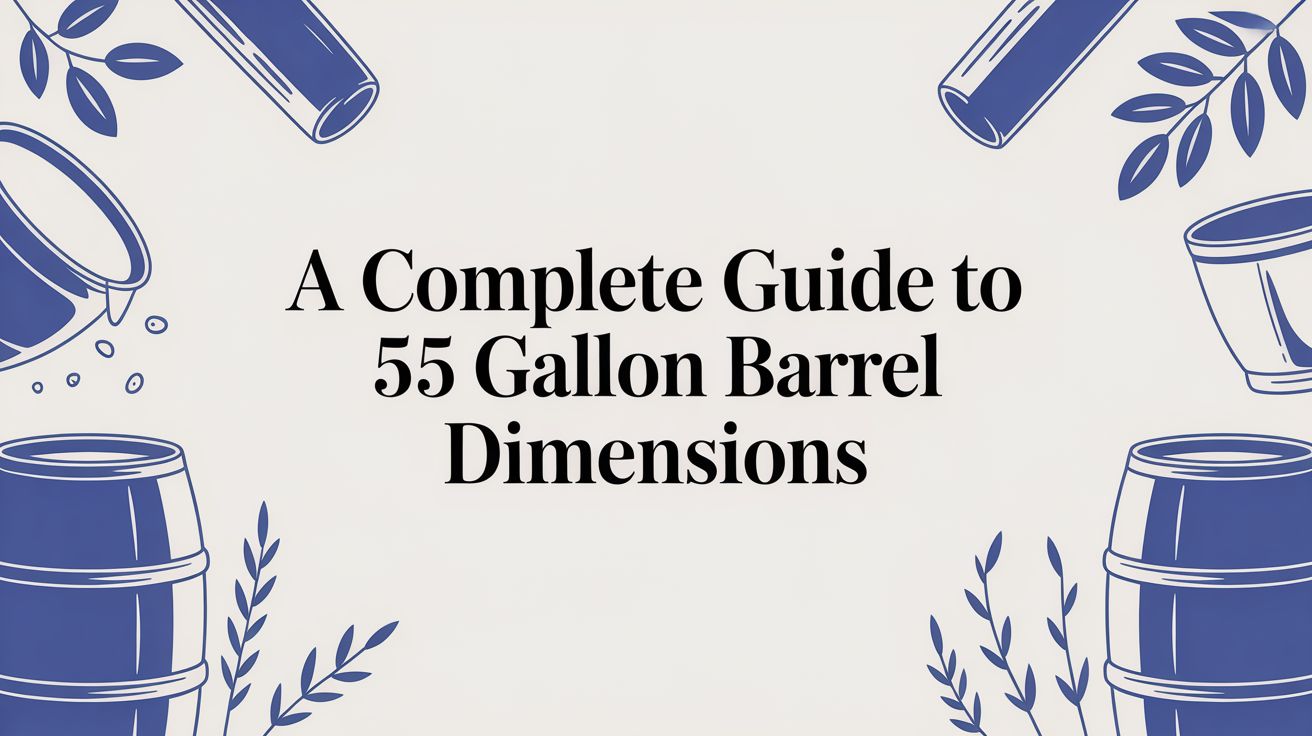
A Complete Guide to 55 Gallon Barrel Dimensions
When you're dealing with a 55-gallon barrel, the standard exterior measurements you can generally count on are a diameter of about 23 inches and a height of around 35 inches. Knowing these numbers is fundamental for planning out your storage area, figuring out shipping logistics, or just making sure your handling equipment will work.
While those dimensions are a solid starting point, you'll find small but important differences depending on what the drum is made of. The manufacturing process for a steel drum isn't the same as for a plastic one, and that affects the final size.
Steel vs. Plastic Barrel Dimensions
It's a common misconception that all 55-gallon barrels are identical. The material—usually either carbon steel or a tough high-density polyethylene (HDPE) plastic—changes the specs. These subtle differences in size and weight can influence everything from how you arrange them on a pallet to meeting certain transport rules. If you're working with different units, a handy unit conversion tool for feet to inches can help keep your numbers straight.
This infographic gives a quick visual rundown of the typical height and diameter for both steel and plastic drums, showing how they stack up against each other.

You can see that plastic barrels tend to be a little bit taller and wider than their steel cousins. It might not seem like much, but that extra inch can make all the difference when you're trying to squeeze them into a tight spot.
Standard 55 Gallon Barrel Specifications
For a more detailed look, here’s a quick-reference table that breaks down the key specs for both steel and plastic drums. This makes it easy to compare them side-by-side.
Specification Standard Steel Drum Standard Plastic Drum Exterior Diameter ~23 inches (584 mm) ~23.3 inches (592 mm) Exterior Height ~34.5 inches (876 mm) ~36.4 inches (924 mm) Empty Weight (Tare) 40-50 lbs (18-23 kg) 20-25 lbs (9-11 kg) Nominal Volume 55 US Gallons 55 US Gallons Ultimately, whether you choose steel or plastic, these dimensions provide a reliable baseline for planning your operations. Always double-check the exact specifications from your supplier if your space and weight constraints are tight.
Standard Steel Drum Specifications
When you think of an industrial container, the 55-gallon steel drum is probably the first thing that comes to mind. It's the go-to for a reason. Thanks to its incredibly tough build and standardized design, it's become a fixture in global logistics, especially for hauling chemicals, oils, and other sensitive materials. The typical 55-gallon barrel dimensions are so consistent that entire storage and transport systems are built around them.

These common measurements weren't an accident; they were critical for making things safer and more efficient. The standardization of the 55-gallon drum was particularly important for industrial growth in California, shaping logistics and hazardous material handling since the mid-20th century. By the 1950s, this drum—measuring about 23 inches in diameter and 34.5 inches in height—was the workhorse for moving bulk liquids across the state's huge manufacturing and agricultural industries. If you're curious about the backstory, Container Exchanger has a great piece on the history of metal barrels.
Open-Head Versus Closed-Head Drums
Not all steel drums are the same. They generally come in two main flavours, and the one you choose depends entirely on what you're putting inside it.
- Open-Head Drums: These have a lid that comes completely off, held in place by a sturdy bolt or lever-lock ring. It's the perfect setup for solids, powders, or really thick liquids because you can get them in and out easily.
- Closed-Head (or Tight-Head) Drums: These drums are sealed shut. The top is permanently fixed, with only a couple of small, threaded holes called bungs (usually one 2-inch and one ¾-inch opening). This design is essential for thinner liquids, as it's the best way to stop leaks or contamination on the move.
The Role of Steel Gauge
The toughness of a steel drum comes down to its steel gauge—basically, how thick the steel is. It's a bit counterintuitive, but a lower gauge number means thicker, stronger steel that can take more of a beating.
For example, a heavy-duty 16-gauge (1.5 mm) drum is built like a tank compared to a standard 18-gauge (1.2 mm) or a lighter 20-gauge (0.9 mm) drum. This thickness doesn't just make it more durable; it also affects the drum's empty weight and is a critical factor when dealing with hazardous materials where you absolutely have to meet strict regulations.
A Look at Plastic Drum Dimensions
When you think of a 55-gallon drum, the classic steel barrel might come to mind, but plastic drums have become just as common—and for good reason. These are usually made from a tough, high-density polyethylene (HDPE) using a process called blow-moulding. This gives them a slightly different set of dimensions compared to their steel cousins.
The blow-moulding process also allows for more flexibility in the design, like adding molded-in handles or unique contours right into the barrel's body.

One of the biggest pluses for plastic barrels is their incredible resistance to rust and corrosion. This makes them a top choice for storing things like water, food-grade materials, and a whole range of chemicals that would eat away at steel. They're also much lighter, with an empty weight (or tare weight) of just 20-25 lbs. This not only makes them easier to move around but can also help trim down shipping costs. If you're thinking about setting up a rainwater system, you can find more details on how a drum of water can be a huge benefit.
Common Measurements for Plastic Drums
You'll find that plastic drums are often a bit larger than steel ones, though the exact size can vary. A very common size you’ll see from major suppliers is about 23.3 inches in diameter and 36.375 inches in height. That extra bit of height often helps accommodate better sealing systems, which is great for keeping contaminants out.
What really sets HDPE barrels apart is how versatile they are. People use them for everything from harvesting rainwater to building floating docks. Their durability and the fact they don't react with most chemicals mean they can be reused for countless projects, not just industrial storage.
Thanks to the way they’re made, plastic drums often have some handy features built right in.
- Molded Handles: Many designs feature handles at the top. While this can make the drum slightly wider, it makes a world of difference when you need to tip or move it by hand.
- Reinforcing Rings: Instead of the sharp, defined rolling hoops on a steel drum, plastic barrels have smoother, thicker bands molded into the drum wall to give it strength.
These practical design touches are why plastic barrels have become such a popular option for so many different uses.
A Word on Tolerances and Regulations
While we talk about "standard" dimensions, it's important to remember that not every 55-gallon drum is a perfect clone of the next. Manufacturing isn't an exact science, and there are always tiny variations—what we call dimensional tolerances.
These slight differences in height or diameter might only be a fraction of an inch, but they can become a huge deal. If you're using automated handling systems, building custom storage racks, or packing a shipping container down to the last centimetre, those small variations suddenly matter a lot.
Sticking to the Standards
For most everyday uses, a small difference here or there won't cause any problems. But when you're working with regulated materials or precision equipment, those tolerances are absolutely critical.
This is where regulatory bodies like the UN and DOT come in. They set specific dimensional ranges to guarantee safety and consistency, especially when you're transporting hazardous materials. A drum has to be within these accepted limits to be considered compliant. It’s all about making sure the drum fits the handling equipment properly and maintains its integrity under pressure. Getting it wrong can lead to hefty fines and serious delays.
If your setup is precision-engineered, always get the exact spec sheet from your supplier. Don't just rely on the nominal measurements. I’ve seen people design entire systems around a standard footprint only to find out their drums are a half-inch too wide—a costly mistake.
Keep in mind that local rules can also come into play. A great example is California, where the Environmental Protection Agency has its own strict rules for hazardous waste drums. As of 2023, 95% of these drums must have an exterior diameter between 23” and 24.5” and a height between 33” and 36.75”. You can learn more about these specific barrel size regulations and their enforcement. It’s a perfect reminder to do your homework on any regional laws that might affect your operations.
Calculating Barrel Weight and Volume Capacity
Knowing a barrel's physical dimensions is a great start, but to handle them safely and efficiently, you really need to get a handle on their weight and actual liquid capacity. The first piece of the puzzle is the empty weight, what we call the tare weight.
Your standard steel drum is surprisingly heavy on its own, tipping the scales at 18 to 23 kg. In contrast, a plastic (HDPE) version is much lighter, usually weighing in at just 9 to 11 kg.
That weight difference really adds up once the barrel is full. The final, or gross, weight is all about what you put inside. Using water as a baseline, a 55-gallon barrel comes in at a hefty 220 kg (almost 500 lbs). If you're storing something denser, like oil or certain chemicals, that total weight will climb even higher.
Usable Volume Versus Nominal Capacity
Here’s something that trips people up: a 55-gallon barrel doesn't actually hold 55 usable gallons. The nominal capacity is the number on the label, but the actual usable volume is always a bit less. Why? You have to leave room for expansion.
This empty space at the top is called headspace, and it's absolutely crucial. It gives the contents room to expand or contract with temperature changes, preventing dangerous pressure build-up that could cause leaks or even a rupture during transport. As a rule of thumb, it's smart to plan your needs around a usable volume of about 53 to 54 gallons.
When you're calculating shipping costs or making sure a truck isn't overloaded, always work with the full weight of the barrel. Getting this wrong can lead to serious safety issues, damaged equipment, or expensive fines. For a quick conversion, our guide on converting 55 gallons to litres is a great resource.
Getting these weight and volume details right from the start means you can choose the proper handling gear—like the right forklift or drum dolly—and plan your storage and shipping without any costly surprises.
Getting Palletizing and Storage Right
Handling 55-gallon barrels properly is about more than just moving them around; it's a huge part of warehouse safety and making the most of your space. How you arrange them on a pallet matters, because their size directly affects how stable the whole load will be.
Getting the layout right is key to keeping everything—and everyone—safe.

When you're securing barrels for transport or storage, the main objective is solid pallet stability. This means spreading the weight evenly across the pallet and using good quality strapping or shrink wrap so nothing shifts unexpectedly.
Stacking and Pallet Arrangement
To keep things running smoothly and safely, stick to these proven guidelines for palletizing your barrels.
- Pallet Configuration: The go-to setup is four drums per standard 48" x 40" pallet. This arrangement creates a tight, secure fit that keeps the barrels from jostling around.
- Stacking Height: As a rule of thumb, don't stack loaded pallets more than two high. But always, always check your facility's safety rules first. The combined weight of filled drums can be immense, and you need to be sure your pallets and flooring can handle it.
- Spill Containment: If you're storing anything hazardous or liquids that could harm the environment, using a spill containment pallet isn't just a good idea—it's often a requirement. These pallets are built with a basin to catch any leaks or spills before they become a bigger problem. You can find more info on picking the right one here: https://ibctanks.ca/spill-containment-pallet/.
Following these simple practices will make your storage area safer, tidier, and far more efficient.
Your Questions Answered: A Barrel Dimensions FAQ
When you're dealing with 55-gallon barrels, a few practical questions always seem to pop up, especially when you're trying to figure out storage or transport. Let's get straight to the answers for some of the most common ones.
Will a 55-Gallon Barrel Fit Through a Standard Doorway?
Yes, it almost certainly will. Your typical interior door in Canada is about 30 to 32 inches wide, with exterior doors usually being a bit wider at 36 inches.
A standard 55-gallon barrel measures about 23 to 24 inches across. That leaves you plenty of wiggle room to get it through most residential or commercial doorways without a struggle. It’s always a good idea to measure your specific door frame first, just in case you're dealing with an older or custom-built entryway.
Are All Bung Holes the Same Size?
Not always, but there's a widely accepted standard you can count on. The vast majority of closed-head barrels, whether they're steel or plastic, come with two threaded openings, which we call bung holes.
You'll almost always find one large 2-inch National Pipe Thread (NPT) bung and a smaller ¾-inch NPT bung. This standardization is a huge help because it means pumps, faucets, and other fittings are easy to find and swap between drums.
How Can I Tell If a Barrel Is Food-Grade?
Good question, and a very important one. To know for sure if a barrel is safe for food or drinking water, you need to look for specific markings on the drum itself.
Keep an eye out for a cup-and-fork symbol, or stamps that say "NSF" (for NSF International) or "FDA Approved." Food-grade barrels are also typically made from new, virgin high-density polyethylene (HDPE) plastic—you'll often see the #2 recycling symbol on them. If you're storing anything for consumption, confirming these markings is a must.
For all your bulk liquid storage needs, from new food-grade barrels to reconditioned IBC totes, IBC Tanks Canada offers a reliable supply and expert support. Find the right container for your project at https://ibctanks.ca.

